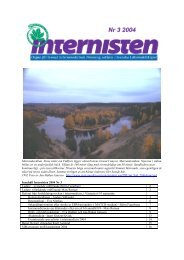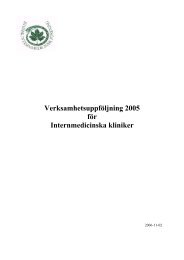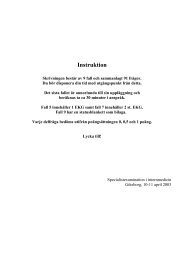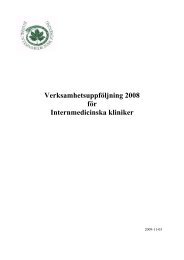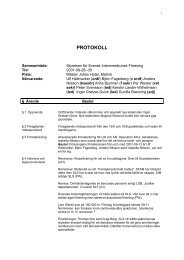Instruktion
Instruktion
Instruktion
Create successful ePaper yourself
Turn your PDF publications into a flip-book with our unique Google optimized e-Paper software.
Vol. 334 No. 21 CARVEDILOL AND MORBIDITY AND MORTALITY IN CHRONIC HEART FAILURE 1351<br />
percent) in the carvedilol group; this difference represents<br />
a 65 percent decrease in the risk of death (95 percent<br />
confidence interval, 39 to 80 percent; P0.001)<br />
in<br />
patients assigned to carvedilol (Fig. 1). Treatment with<br />
the drug was associated with a large decrease in the<br />
risk of dying of progressive heart failure and in the risk<br />
of sudden death (Table 2). The reduction in mortality<br />
due to carvedilol was similar regardless of age, sex, the<br />
cause of heart failure, ejection fraction, exercise tolerance,<br />
systolic blood pressure, heart rate, or protocol assignment<br />
(Table 3).<br />
Effect of Carvedilol on Cardiovascular Morbidity<br />
During double-blind therapy, 98 patients (14.1 percent)<br />
in the carvedilol group and 78 patients (19.6 percent)<br />
in the placebo group had at least one hospitalization<br />
for cardiovascular causes; this difference represents<br />
a 27 percent reduction in the risk of hospitalization (95<br />
percent confidence interval, 3 to 45 percent; P0.036).<br />
To avoid the analytic problem of competing risks (since<br />
patients who have died cannot be hospitalized), the effect<br />
of carvedilol on the combined risk of death or hospitalization<br />
for cardiovascular causes was evaluated with<br />
the use of a time-to-first-event analysis. As tested for significance<br />
with use of the log-rank test, the combined risk<br />
of either dying or being hospitalized for cardiovascular<br />
reasons was reduced from 24.6 percent in the placebo<br />
group to 15.8 percent in the carvedilol group, a 38 percent<br />
reduction (95 percent confidence interval, 18 to 53<br />
percent; P0.001)<br />
(Fig. 2).<br />
Safety<br />
Table 1. Pretreatment Characteristics of Patients in<br />
the Study. *<br />
CHARACTERISTIC<br />
PLACEBO<br />
(N<br />
398)<br />
*Plus–minus values are means SD.<br />
ACE denotes angiotensin-converting<br />
enzyme.<br />
†The cause of heart failure was not recorded for one patient in the placebo<br />
group and two in the carvedilol group.<br />
At the end of double-blind therapy, the mean heart<br />
rate decreased significantly more in the carvedilol group<br />
CAPS:CAPS Shipped Pages:may23.96:1pack.oa<br />
Wed May 22 96 12:05:04<br />
CARVEDILOL<br />
(N<br />
696)<br />
Age (yr) 58.112.3<br />
57.912.2<br />
Sex (M/F) 304/94 534/162<br />
New York Heart Association class<br />
II<br />
III<br />
IV<br />
Cause of heart failure†<br />
Coronary artery disease<br />
Nonischemic dilated cardiomyopathy<br />
208<br />
177<br />
13<br />
189<br />
208<br />
374<br />
303<br />
19<br />
332<br />
362<br />
Left ventricular ejection fraction 0.220.07<br />
0.230.07<br />
Six-minute walk (m) 38696<br />
39090<br />
Systolic blood pressure (mm Hg) 11517<br />
11617<br />
Diastolic blood pressure (mm Hg) 7311<br />
7210<br />
Heart rate (beats/min) 8312<br />
8412<br />
Medication (% of patients)<br />
Digitalis<br />
Loop diuretic<br />
ACE inhibitor<br />
Direct-acting vasodilator<br />
90<br />
95<br />
95<br />
32<br />
91<br />
95<br />
95<br />
32<br />
than in the placebo group (by 12.612.8<br />
beats per<br />
minute vs. 1.412.2,<br />
P0.001),<br />
although neither group<br />
had significant changes in systolic or diastolic blood<br />
pressure. Frequently reported adverse reactions are<br />
listed in Table 4; those necessitating discontinuation of<br />
the study drug are shown in Table 5. The most common<br />
side effect of carvedilol was dizziness, which occurred<br />
during the initiation of therapy or during the<br />
dose-adjustment period but which subsided either spontaneously<br />
or after the adjustment of concomitant medications;<br />
it did not generally lead to the withdrawal<br />
of treatment with the study drug. The most common<br />
reason for the discontinuation of double-blind treatment<br />
was worsening heart failure, which occurred<br />
more frequently in the placebo group. Overall, 7.8 percent<br />
of the placebo group and 5.7 percent of the carvedilol<br />
group discontinued the study medication because<br />
of adverse reactions; 1.5 percent and 1.1 percent,<br />
respectively, were withdrawn from the study medication<br />
after cardiac transplantation. When the program<br />
was terminated, more patients were receiving or had<br />
completed double-blind treatment in the carvedilol<br />
group than in the placebo group (89 percent vs. 83 percent,<br />
P0.002).<br />
DISCUSSION<br />
The present report indicates that the addition of<br />
carvedilol to conventional therapy is associated with a<br />
decrease in mortality among patients with chronic heart<br />
failure. Patients treated with carvedilol had a 65 percent<br />
lower risk of death than those given placebo during<br />
follow-up that averaged 6.5 months and extended to<br />
15 months. The beneficial effect of carvedilol on survival<br />
was consistent in all evaluated subgroups and was reflected<br />
in a decrease in the risk of death from progressive<br />
heart failure as well as in the risk of sudden death.<br />
Probability of Survival<br />
NO. AT RISK<br />
Placebo<br />
Carvedilol<br />
1.00<br />
0.95<br />
0.90<br />
0.85<br />
0.80<br />
0.75<br />
0.70<br />
0.65<br />
0.60<br />
0.55<br />
0 50 100 150 200 250 300 350 400<br />
398<br />
696<br />
353<br />
637<br />
329<br />
581<br />
Days of Therapy<br />
305<br />
546<br />
163<br />
314<br />
71<br />
131<br />
55<br />
106<br />
Carvedilol<br />
Placebo<br />
43<br />
83<br />
3<br />
11<br />
Figure 1. Kaplan–Meier Analysis of Survival among Patients<br />
with Chronic Heart Failure in the Placebo<br />
and Carvedilol Groups.<br />
Patients in the carvedilol group had a 65 percent lower risk of<br />
death than patients in the placebo group (P0.001).



